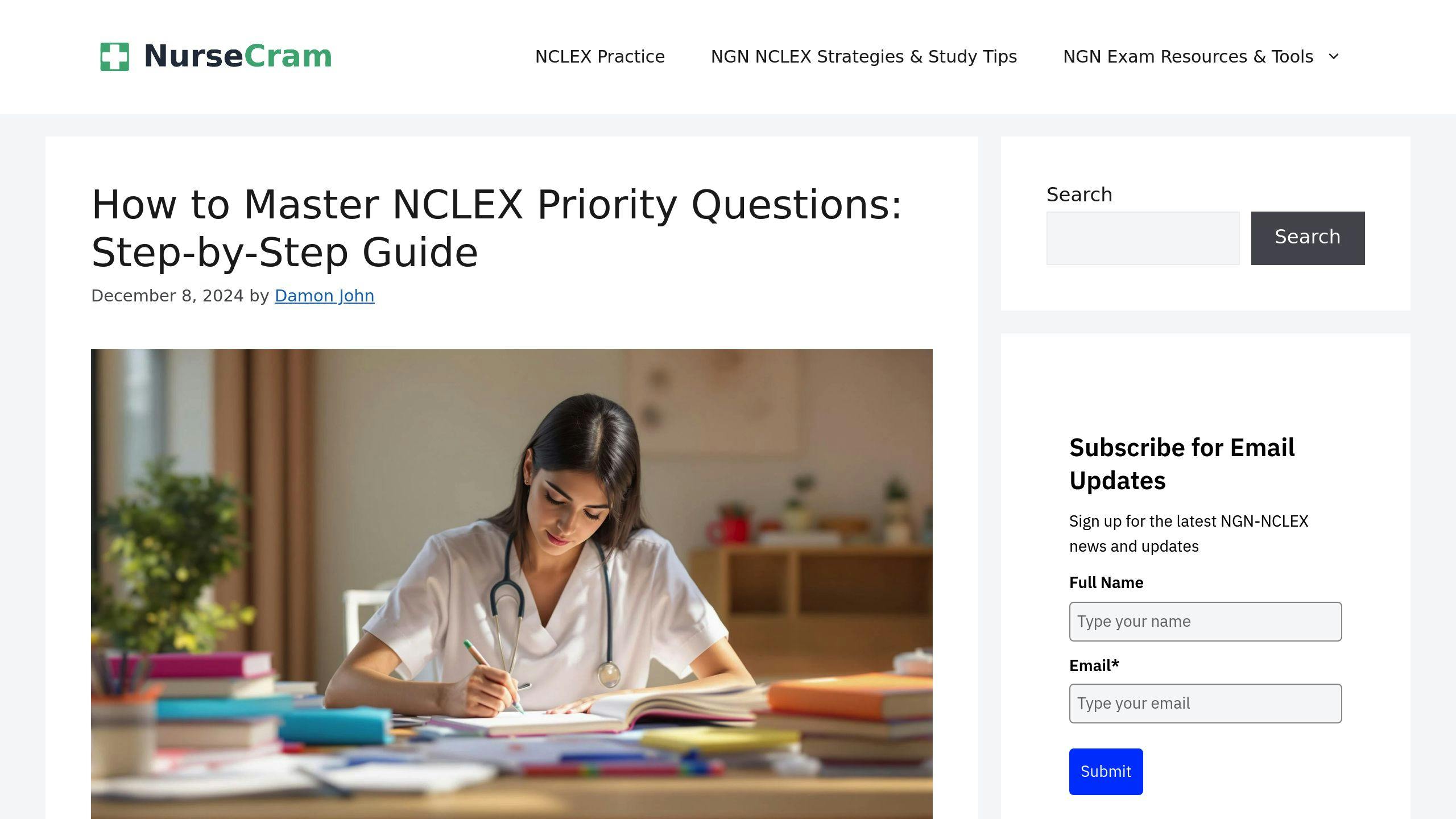Suicide risk assessment is a critical skill for nurses, especially when preparing for the NCLEX. The process involves five key steps:
- Identify Risk and Protective Factors: Look for mental health issues, past attempts, substance abuse, or major stressors while noting protective factors like social support.
- Ask Direct Questions About Suicide: Use clear, empathetic language to assess thoughts, intent, and plans.
- Assess Risk Level: Tools like the Columbia-Suicide Severity Rating Scale (C-SSRS) help evaluate the seriousness of risk.
- Plan Interventions: Match actions to risk level, including supervision, removing harmful items, or arranging psychiatric care.
- Document and Plan Follow-Up: Record all findings, actions, and future care plans thoroughly.
These steps are essential for both patient safety and passing NCLEX scenario-based questions. Focus on understanding validated tools like C-SSRS and SAFE-T, and practice applying these principles in realistic scenarios. Your ability to assess and act on suicide risks can save lives and ensure exam success.
Building A Better Suicide Risk Assessment: The Columbia Protocol C-SSRS
Steps for Conducting a Suicide Risk Assessment
These steps are essential for assessing suicide risk effectively and are often tested on the NCLEX through scenario-based questions.
Step 1: Identify Risk and Protective Factors
Start by looking for risk factors like mental health issues, previous suicide attempts, substance abuse, family history of suicide, or recent major life stressors [1][3]. Also, consider protective factors such as strong social connections, a sense of hope, and future-oriented thinking [3].
Step 2: Ask Direct Questions About Suicide
Use straightforward, empathetic language to ask about suicidal thoughts. Avoid judgment, and focus on clarity. Here are some key questions:
| Question Type | Example |
|---|---|
| Initial Screening | "Have you ever thought about harming yourself?" |
| Intent Assessment | "On a scale of 0 to 10, how serious are you about taking your own life?" |
| Plan Evaluation | "Do you have a specific plan to take your own life?" |
These questions help you gauge the presence, urgency, and seriousness of suicidal intent [5].
Step 3: Assess the Level of Risk
Use tools like the Columbia-Suicide Severity Rating Scale (C-SSRS) to evaluate risk. Consider the frequency of suicidal thoughts, the detail of any plans, access to methods, and history of attempts [3].
Step 4: Respond Based on Risk Level
Adjust your response to the patient’s risk level. For those at high risk, immediate actions may include:
- One-to-one supervision
- Removing access to harmful tools or substances
- Arranging an emergency psychiatric assessment
- Coordinating admission to a suitable care facility [1][3]
Step 5: Document and Plan Follow-Up Care
Thorough documentation is vital for care continuity and legal purposes. Be sure to include:
- Details of your assessment and findings
- Patient’s answers to your questions
- Risk level assessment
- Actions taken
- Follow-up care plans [2][3]
Set up a clear follow-up schedule with regular check-ins and monitoring. Share the care plan with the team to ensure everyone is informed about the patient’s status.
Understanding and applying these steps is crucial for ensuring patient safety and performing well on the NCLEX, where these principles are tested in scenario-based questions.
How to Prepare for Suicide Risk Assessment Questions on the NCLEX
Once you’ve got a handle on the steps of risk assessment, it’s time to focus on how these concepts are tested on the NCLEX.
Practice Scenario-Based Questions
Platforms like Nurse Cram NCLEX Exam Review offer scenario-based exercises that sharpen critical thinking. These exercises help you practice recognizing risk factors, choosing interventions, and documenting care effectively. Key areas to focus on include:
- Recognizing risk factors and warning signs
- Understanding how to use assessment tools
- Selecting interventions based on the level of risk
- Practicing accurate documentation and care planning
Get Comfortable with Assessment Tools
Spend time learning tools like the Columbia-Suicide Severity Rating Scale (C-SSRS) and SAD PERSONS. These tools often come up in NCLEX scenarios [3]. Know how they’re used to evaluate the seriousness of suicidal thoughts and actions and how they guide initial assessments. This knowledge is essential for making informed decisions during the exam.
Manage Your Time and Answer Questions Strategically
When handling complex NCLEX questions about suicide risk:
- Pinpoint the key risk factors and warning signs in the scenario.
- Use the nursing process step by step.
- Rule out answers that don’t align with suicide risk assessment principles.
Success on these questions means blending your clinical knowledge with smart test-taking strategies. Pairing these skills with the right study tools will boost your preparation even further.
sbb-itb-aa73634
Resources to Help You Prepare for the NCLEX
Use Nurse Cram NCLEX Exam Review

The Nurse Cram NCLEX Exam Review provides tools specifically designed to help you grasp suicide risk assessment concepts. Its Next Generation NCLEX (NGN) prep features include:
| Feature | What It Helps You Do |
|---|---|
| Scenario-Based Exercises and Clinical Judgment Tools | Practice decision-making in realistic situations to assess risk levels |
| Comprehensive Readiness Exams | Test your understanding of assessment protocols and interventions |
| Detailed Answer Rationales | Learn the reasoning behind each step in the assessment process |
Explore Other Study Tools
In addition to Nurse Cram, tools like the SAFE-T Pocket Card and C-SSRS are essential for tackling NCLEX questions about suicide risk assessment. These proven frameworks, combined with up-to-date psychiatric nursing textbooks that align with NCLEX standards, offer a structured way to approach suicide risk evaluation [2][3].
Conclusion and Final Thoughts
Now that we’ve gone over how to approach NCLEX questions, let’s take a moment to revisit the key steps in suicide risk assessment. These steps are not just essential for passing the NCLEX – they’re critical for developing clinical skills that can save lives.
Recap of Suicide Risk Assessment Steps
Suicide risk assessment is built on a five-step process: identifying risks, asking direct questions, evaluating risk, implementing interventions, and documenting everything clearly. These steps are the backbone of effective prevention.
Timing plays a huge role here – suicide risk is highest during the first 24 hours after admission and near discharge [4]. This is especially crucial when working with older adults, who statistically face the highest suicide rates [4].
How to Tackle NCLEX Questions on This Topic
To handle NCLEX questions involving suicide risk assessment, focus on applying these steps in real-world scenarios. Here’s what to keep in mind:
- Evaluate risk factors and protective elements in a structured way.
- Communicate clearly and professionally in patient scenarios.
- Match interventions to the risk level with precision.
- Ensure your documentation is thorough and accurate.
Pay special attention to questions involving older adults, as their risk is higher [4]. Use your clinical judgment to go beyond rote memorization and show you understand how these principles work in practice.
FAQs
What are the five steps of the suicide assessment process?
Here’s a clear breakdown of the five steps involved:
| Step | Description | Key Actions |
|---|---|---|
| 1. Risk & Protective Factor Assessment | Understand the patient’s current situation | Evaluate mental health, substance use, and social support |
| 2. Suicide Inquiry | Ask directly about suicidal thoughts or plans | Discuss ideation, past attempts, and access to methods |
| 3. Risk Level Determination | Assess the seriousness and urgency | Use tools like ASQ to evaluate risk and protective factors |
| 4. Intervention Planning | Develop a plan based on the risk level | Implement safety measures or hospitalization if needed |
| 5. Documentation & Follow-up | Record and plan for ongoing care | Document findings, actions, and follow-up steps |
These steps are part of a structured process crucial for clinical practice and NCLEX preparation. Tools like SAD PERSONS and C-SSRS can help standardize risk evaluations and guide the next steps.
When assessing, consider both risks (e.g., previous attempts, mental health issues) and protective factors (e.g., hope, social connections). For a deeper dive into risk and protective factors, refer to Step 1 in the earlier section.
Clear documentation and follow-up planning are critical for ensuring continuity of care and meeting legal requirements. Always record findings, actions taken, and your rationale to provide effective care and maintain legal safeguards.
Mastering this process not only enhances patient safety but also prepares you for NCLEX scenario-based questions that test your ability to make sound clinical judgments.
Related posts
- 12 NCLEX Mental Health Questions to Practice
- NGN Case Studies: Spotting Key Clinical Cues
- 6 Clinical Judgment Skills for Analyzing Patient Data
- Case Studies: Medication Administration for NGN NCLEX

Mia is dedicated to helping nursing students and new graduates confidently prepare for the Next Generation NCLEX exam. With a focus on providing clear, actionable advice and support, Mia offers practical study tips, effective strategies, and encouragement to guide you through the complexities of nursing exams. Whether you need help mastering question formats, managing stress, or creating a personalized study plan, Mia is here to ensure you feel prepared and empowered every step of the way.

